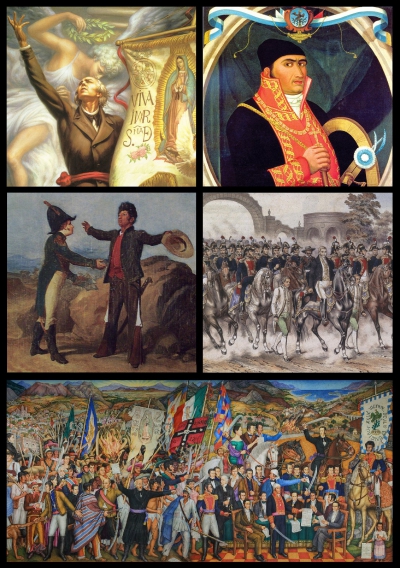The Plan of Iguala, also known as The Plan of the Three Guarantees ("Plan Trigarante") or Act of Independence of North America, was a revolutionary proclamation promulgated on 24 February 1821, in the final stage of the Mexican War of Independence from Spain. The Plan stated that Mexico was to become a constitutional monarchy, whose sole official religion would be Roman Catholicism, in which the Peninsulares and Creoles of Mexico would enjoy equal political and social rights. It took its name from the city of Iguala in the modern-day state of Guerrero.
The two main figures behind the Plan were Agustn de Iturbide (who would become Emperor of Mexico) and Vicente Guerrero, revolutionary rebel leader and later President of Mexico. The Army of the Three Guarantees was formed by the unified forces Iturbide and Guerrero to defend the ideals of the Plan of Iguala. On 24 August 1821, Iturbide and Spanish Viceroy Juan O'Donoj signed the Treaty of Crdoba in Crdoba, Veracruz, ratifying the Plan of Iguala, and thus confirming Mexico's independence.
The Plan, a compromise, introduced new ideas and preserved others. For example, it established a new army, but it preserved the constitutional right of all males to vote regardless of origin, race, or economic condition, which had been enshrined in the Constitution of 1812 and which was en force at the time of the Plan.
The Mexican War of Independence (Spanish: Guerra de Independencia de México, 16 September 1810 – 27 September 1821) was an armed conflict and political process resulting in Mexico's independence from Spain. It was not a single, coherent event, but local and regional struggles that occurred within the same time period, and can be considered a revolutionary civil war. Independence was not an inevitable outcome, but events in Spain itself had a direct impact on the outbreak of the armed insurgency in 1810 and its course until 1821. Napoleon Bonaparte's invasion of Spain in 1808 touched off a crisis of legitimacy of crown rule, since he had placed his brother Joseph on the Spanish throne after forcing the abdication of the Spanish monarch Charles IV. In Spain and many of its overseas possessions, the local response was to set up juntas ruling in the name of the Bourbon monarchy. Delegates in Spain and overseas territories met in Cádiz, Spain, still under Spanish control, as the Cortes of Cádiz, which drafted the Spanish Constitution of 1812. That constitution sought to create a new governing framework in the absence of the legitimate Spanish monarch. It tried to accommodate the aspirations of American-born Spaniards, for more local control and equal standing with Peninsular-born Spaniards, known locally as Peninsulares. This political process had far reaching impacts in New Spain, during the independence period and beyond. Pre-existing cultural, religious and racial divides in Mexico played a major role in not only the development of the independence movement but also the development of the conflict as it progressed.In September 1808 peninsular-born Spaniards in New Spain overthrew the rule of Viceroy José de Iturrigaray (1803–08), who had been appointed before the French invasion. In 1810, American-born Spaniards in favor of independence began plotting an uprising against Spanish rule. It occurred when the parish priest of the village of Dolores, Miguel Hidalgo y Costilla, issued the Cry of Dolores on 16 September 1810. The Hidalgo revolt began the armed insurgency for independence, lasting until 1821. The colonial regime did not expect the size and duration of the insurgency, which spread from the Bajío region north of Mexico City to the Pacific and Gulf Coasts. With Napoleon's defeat, Ferdinand VII succeeded to the throne of the Spanish Empire in 1814, and promptly repudiated the constitution and returned to absolutist rule. When Spanish liberals overthrew the autocratic rule of Ferdinand VII in 1820, conservatives in New Spain saw political independence as a way to maintain their position. Former royalists and old insurgents formed an alliance under the Plan of Iguala and forged the Army of the Three Guarantees. The momentum of independence saw the collapse of royal government in Mexico and the Treaty of Córdoba ended the conflict.The mainland of New Spain was organized as the Mexican Empire. This ephemeral Catholic monarchy was overthrown and a federal republic declared in 1823 and codified in the Constitution of 1824. After some Spanish reconquest attempts, including the expedition of Isidro Barradas in 1829, Spain under the rule of Isabella II recognized the independence of Mexico in 1836.

1821Feb, 24
Final stage of the Mexican War of Independence from Spain with Plan of Iguala.
Choose Another Date
Events on 1821
- 22Feb
Danubian Principalities
Greek War of Independence: Alexander Ypsilantis crosses the Prut river at Sculeni into the Danubian Principalities. - 26May
Greek War of Independence
Establishment of the Peloponnesian Senate by the Greek rebels. - 9Jul
Greek War of Independence
Four hundred and seventy prominent Cypriots including Archbishop Kyprianos are executed in response to Cypriot aid to the Greek War of Independence - 23Jul
Monemvasia
While the Mora Rebellion continues, Greeks capture Monemvasia Castle. Turkish troops and citizens are transferred to Minor Asia coasts. - 28Nov
Gran Colombia
Panama Independence Day: Panama separates from Spain and joins Gran Colombia.

 English
English  español
español  français
français  português
português  русский
русский  العربية
العربية  简体中文
简体中文 